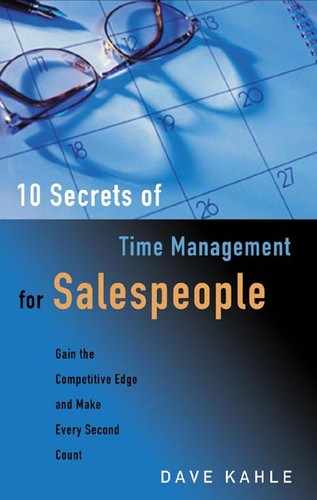In the last chapter, we looked at the importance of being systematic in your approach to the repetitive tasks that you must perform. In this chapter, we’re taking the same approach to the major task that you face—the Big One.
And you’re wondering, “What’s the Big One?” It’s selling. In other words, the big task, the reason your company hired you, the value you bring to your company, the heart of the sales job, is this—influencing your customers to purchase your products and services.
That’s it. All the other things are peripheral to this one task. It is the essence of your job. And if you are systematic about accomplishing this major task, you’ll take great leaps forward in your effectiveness and efficiency. You’ll become a superstar of time management, and a producer of extraordinary results.
Too many salespeople are haphazard and unstructured in their approach to selling. They have no process they follow, no model by which to understand and organize their efforts. Their sales calls are only minimally planned, if at all. Their strategy in an account is limited to thinking about their next sales call. As a result, their efforts are often unfocused, and they waste tremendous amounts of their time as well as their customers’ time.
The key is to have a clear model of how you go about selling, and then to fit all of your efforts into this model. In a moment, I’ll share with you my model—the Target System. First, let’s consider some of the benefits of using this approach to your major responsibility.
![]()
Benefits to using a sales process model
A well-defined effective sales process provides you a way to think about each customer and prospect, and put your efforts into a context. Sales calls aren’t made just to make them. Rather, you see every sales call as a step forward in the process. So you have a specific objective in mind for each sales call, and an overall strategy for every account and every opportunity within each account.
Your adherence to a sales process, then, keeps you focused on the most important outcomes (your sales call objectives) for the most important interactions (your face-to-face sales calls) of the most important part of your job (your relationships with your customers). This powerful tool prevents you from squandering time and effort.
The Target System
This is called the Target system after one of the visual images I use to illustrate some of the key aspects of the process.
Let’s first look at the whole process, then, briefly describe each of the steps to the process. Here’s a diagram of the process:
Primary Sales Process

1. Build relationships.
This step of the process is illustrated by the oilcan. The idea is that the relationships you create with your customers lubricate the rest of the process, making everything else easier. It is possible for you to sell without great relationships with your customers. It’s just extremely difficult. If your customers know you, trust you, and are comfortable with you, it makes everything else much easier. It’s like oiling the gears in a machine. It might work without it, but the oil makes everything move more easily.
The oilcan is pictured in the center of the process because it is central to all you do, with its positive impact spreading to every phase of the sales process, every interaction, and every task associated with it. Further, building relationships is not an event that you complete in a sequential fashion. It is a part of every step in the process.
It’s something you do in every sales call, during every phone call, with every e-mail. Relationships are at the heart of selling.
2. Peel the onion—understand your customer.
Suppose you’ve just come back from your company’s annual sales meeting. For three days, you sat in meetings and ate hotel food. Now you’re home, and you’d like nothing more than a cold drink and a home-cooked meal. You suggest a big salad for dinner, and your spouse agrees, suggesting that you peel the onion.
You get out a big, fat Bermuda onion, one of those that are about the size of a softball. You position it carefully on a cutting board, and root through the drawer until you find a sharp meat cleaver. Steadying the onion with one hand, you raise the meat cleaver above your head, and, with a karate-type movement, smash the meat cleaver neatly into the center of the onion, splitting it evenly in two.
You pick up one of the onion halves and examine it from the inside. You note that it has layers and layers, each deeper and more tightly compressed than the one surrounding it. You begin to peel the onion, stripping off the skin. As you pull off the skin of the onion, you notice that the skin is thin, dry, and crispy, with very little scent. However, as you peel each layer, one at a time, you soon come to the conclusion that each layer is more strongly scented than the one above it, and that the strength of the onion’s pungency comes from the inside out.
That’s the best way to understand this next step in the process. The real beginning to the sales process is working to achieve an understanding of what your customer wants and needs. When you have that understanding, you can move to the next step of the process, which is matching your products or services to those needs.

Just like there are layers and layers to an onion, there are layers and layers to your customer. Just like the superficial layers of an onion are thin and mild, the superficial levels of your customers have little strength. But as you peel the onion deeper and deeper, the strength increases. So, too, with you customer.
Let’s apply this specifically to understanding your customer in a sales situation. Look at the illustration. Imagine it to be a slice of that onion. On the very surface are the technical specifications for the product or service the customer wants. For example, let’s say you call on one of your customers and he says, “I need to purchase three green metal widgets that are 1/2 x 6 inches.” Many salespeople would say, “Okay, they are $2.50 each.” In this example, the salesperson understood the customer at the most superficial level—technical specifications— and responded in kind.
But you can go deeper in understanding the customer by discovering the reason behind those specifications.
Our rep, when confronted with the same request, may say, “What are you going to use them for?” or, “Is there a reason you asked for metal instead of plastic?” This kind of response will uncover the next level, the reason for the specifications.
There’s more. Situation refers to the history behind the need, and the circumstances surrounding the need. For example, let’s say that our salesperson now replies, “John, what’s your situation? Why is this an issue now?” When the customer replies to that question, he has uncovered a deeper layer of need.
Yet you’re still pretty close to the surface. When you uncover the specific problems and objectives under the original request, you deepen your understanding of the customer. Suppose your customer says, “We’re having a problem with our second shift production. The line keeps breaking down. Our maintenance supervisor wants to stockpile some of the parts that he has been regularly replacing.”
Now you have an understanding of the specific problems and objectives. There is more. Suppose you ask how that problem affects the rest of the company. And suppose your customer explains the effect of the breakdown on production, net profits, and overtime pay for the second shift. Now you understand the customer on an even deeper level.
But you can go deeper still. When you ask how those systematic problems affect his business goals, and you learn that it’s particularly troublesome because your customer’s goals are to increase net profits by 5 percent this year, you understand the customer at an even deeper level.
You take a significant plunge deeper when you are able to understand how the situation affects the individual with whom you’re talking. For example, when you know him well enough to ask, “John, how can I make you look good in this transaction?” and get an honest response, you’ve penetrated to a new layer of understanding.
Finally, when you understand the individual motivations— the reasons for the personal factors—you understand customers at levels that few salespeople ever approach. That’s where the masters work. Those motivations are often emotionally driven. So, when you understand the customers’ emotions— how the situation makes them feel, you’ve arrived at the heart of the onion.
![]()
3. Match your products and services to the customer’s needs.
Once you have achieved a deep and detailed understanding of the customer’s needs and interests, the next step is to select and present to the customer your solution—matching your best combination of products and services to his/her needs. Not only do you select and create the best match, in addition, when you present it, you show how your solution matches the customer’s needs.
Let’s say, for example, that you sell a variety of computers, peripherals, and network hardware. Your customer has indicated a need to upgrade several pieces of the system in his customer service call center. When you peeled the onion, you discovered that the call center was being repositioned, strategically, to take over more and more of the detail work that the outside sales force formerly did.
Every other competitor will bring in a bid on equipment. But because you peeled the onion, your proposal shows the customer how they can use your system to continually grow the number and sophistication of the tasks they perform, so that the customer service center will have the computing power to meet their strategic objectives.
Instead of just quoting a price on equipment, you matched your solution to the customer’s deeper needs. Good job. That will distance you from your competitors and make your time spent with this customer more effective.
4. Negotiate the next step.
Assume that you have done a thorough job of matching your solution to the customer’s needs. If so, then it is reasonable to expect that the customer should do something about it. Perhaps he asks for a demonstration or evaluation of your piece of equipment, or some more information, or agrees to take it to the committee, or present it to the boss, or buy it now. Regardless, in every selling process, sooner or later it comes down to the customer agreeing to do something, to take some action as a result of your work. When you gain an agreement with the customer on what exactly that next step is, and a commitment is made to implement that action, you have achieved this step in the process.
5. Leverage satisfaction.
Sooner or later, someone is going to buy something from you. After they have made that decision, and after the product or service has been delivered and used by the customer, then comes the last step in the process. Many salespeople never follow through on what is one of the most powerful sales calls they can make—the follow-up call.
By assuring satisfaction, getting the customer to say, “Yes, it is working well,” or “Yes, it was a good decision,” you open the door for additional opportunities. You leverage that satisfaction to other opportunities either inside or outside of the company. If there is no immediate opportunity within the company to expand your sales and sell more, then you ask for referrals to others who might buy your stuff.
If there is an opportunity to sell more to this customer, then this is the best time to begin that process by discussing that opportunity. And when you have that discussion, guess what? You are back at the “peeling the onion” step of the process with the customer, moving through the sales process again.
Using the sales process
as a time management tool
The Target System is a basic selling system designed to be customized to each company’s unique situation. You may have a process that is considerably more complex than that. I once worked with a client where we designed a 27-step selling process. Regardless of what process you use, the important thing is that you use an effective, reproducible process. This process can become one of your most effective time management tools, because it keeps you focused. Here’s a way to start making use of it. Create a matrix that looks something like this:

For a new product or service introduction
Now, suppose that you have a new product line (Red Widgets) that you want to sell in each of your 10 key accounts. Note Red Widgets at the top, list the 10 accounts down the left column, and then note each step of the sales process in the angled slots on the top. Your matrix now looks like this:

Use this in your weekly or monthly planning to assess what progress you have made, and to focus you on the next step. For example, let’s say that you called on Jones Manufacturing, had lunch with the senior buyer, and discovered that widgets are very important to them. They use $200,000-worth a year, but they are under contract with a competitor for widgets through June of next year. The buyer suggests you introduce the new widget to John Jones, the production engineer, sometime around January.
When you review your notes that afternoon, you note that, as it applies to widgets, you haven’t yet built a relationship with the production engineer. In fact, you don’t know him. And in spite of the information you got from the senior buyer, you really don’t know what they are looking for in a widget, how it fits into their system, etc. You haven’t yet peeled the onion in any but the most superficial way. As it relates to Jones, you haven’t even accomplished step one in the sales process. What’s the next step? Meet and create a relationship with John Jones.
You also called on Smith Brothers. It’s a much smaller organization, and you know everyone, including the owner/CEO. He sees you, and likes your new red widget. You learn how many widgets they use, what problems they’ve had with widgets in the past, why they use the brand they do, how they use them, and what they are currently paying for them from a competitor. What’s your next step in the process? You already have a relationship, you’ve peeled the onion regarding widgets, and you’ve shown him your widget. What now? Negotiate the next step. You propose a trial evaluation, and he agrees. You set up a date and send an e-mail to your customer service teammate with the details, and ask that he order the necessary supplies.
That evening, your matrix looks like this:
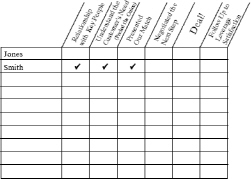
Your use of a sales process has kept you on track, focused you on moving the projects forward, and given you a specific next step. It saves you time and helps you become more effective.
Multiple projects in a single customer
Here’s another way to use the sales process to organize and focus your sales time. Let’s say you sell multiple products or services to your customers. You can use the sales process and the matrix as a way of staying on top of all those projects. Here’s an example. One of your key accounts is Ajax Inc. You have 10 product lines that Ajax can buy from you. So, you set up your matrix with Ajax as the subject, the steps to the sales process in the slots along the top, and each of the 10 product lines in the left-hand column, so that it looks like the following:
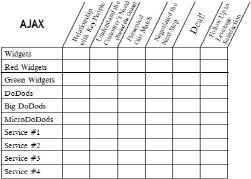
You use it to keep track of your progress on each of those lines. At the end of January, it looks like the following:
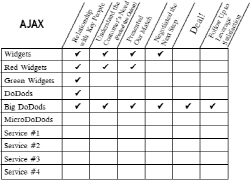
At the end of March, it looks like this:
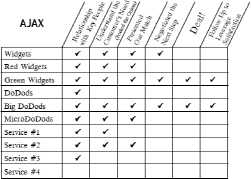
Each month or each week, as you plan for the next series of sales calls, you use it to assess your progress and focus on the next most important step.
You can find other applications for the process concept and the matrix as a tool to implement it. Your process may be different from the Target System I’ve described. That’s fine. The important thing is that you have a well-defined process, and that you use that process as a way of keeping you focused.
As you do, you’ll become more organized, more sure of yourself, and more focused on the important outcomes of every sales call. That sharp focus will make you more effective. You’ll sell more in less time. You’ll make your boss happy and get your life back!
![]()
To implement this management secret:
1. Sketch out your sales process. Work with your sales manager to identify a process if your company doesn’t have one that it teaches.
2. Create the matrices discussed in this chapter, using the steps in your sales process. Or use the forms in the Sales Management Tool Kit.
3. Use this as a tool to keep focused and organized.
